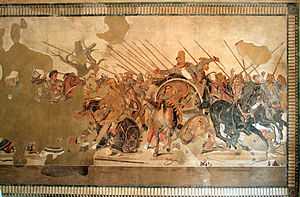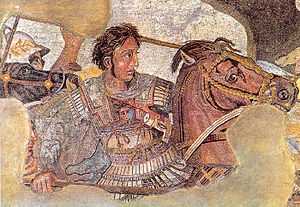Roman mosaic

A Roman mosaic is a mosaic made during the Roman period, throughout the Roman Empire. Mosaics were used in a variety of private and public buildings, often incorporating social, entertaining, mythological or personal scenes within wider geometric patterns.
Technology
Roman mosaics are constructed from geometrical blocks called tesserae,[1] placed together to create the shapes of figures, motifs and patterns.[2] Materials for tesserae were obtained from local sources of natural stone, with the additions of cut brick, tile and pottery creating coloured shades of, predominantly, blue, black, red, white and yellow.[2] Polychrome patterns were most common, but monochrome examples are known.[3] Marble and glass were occasionally used as tesserae,[4] as were small pebbles[5] and precious metals like gold.[6] Mosaic decoration was not just confined to floors but featured on walls and vaults as well. Traces of guidelines have been found beneath some mosaics, either scored into or painted onto the mortar bedding. The design might also be pegged out in string,[2] or mounted in a wooden frame.[7]
The collapse of buildings in antiquity can, paradoxically, both irrevocably destroy mosaics or protect and preserve them.[2]
Development
The earliest examples of Roman floor mosaics are dated to the late Republican period (2nd century BC) and are housed in Delos,[8] though tessellated pavements were used in Europe from the late fifth to early fourth centuries BC.[2]
The outstanding examples of Late Imperial period are the mosaics in the villa of Casale (c. 300 AD) in Sicily. The mosaic decoration of local palace complex culminates in the gallery, which contains a scene of animal hunting and fighting covering an area of 3,200 square feet (300 square metres).[8]
Imagery
As well as geometric patterns and designs, Roman mosaics frequently depicted divine characters or mythological scenes.[9][10]
Portraits
Imagery of famous individuals or entertaining scenes are common on Roman mosaics. The Alexander Mosaic from the House of the Faun, Pompeii depicts the Battle of Issus between Alexander the Great and Darius III.[11] In addition to famous people from antiquity, mosaics can depict aspects of daily life. The Gladiator Mosaic from Rome depicts a fighting scene, naming each gladiator involved. A gladiatorial scene is also known from Leptis Magna.[12]
Religion
One of the earliest depictions of Roman Christianity is a mosaic from Hinton St Mary (in Dorset, England) which shows Christ with a Chi-Rho behind his head. The mosaic is now in the British Museum.[13]
Notable examples
- The Alexander Mosaic from the House of the Faun, Pompeii.
- The Tomb of the Julii in the Vatican Necropolis, beneath St. Peter's Basilica, Rome.
- The Gladiator Mosaic from the Via Casilina outside Rome.
- The Zliten Mosaic from Zliten in Libya.
Gallery
-

Detail of Alexander Mosaic, depicting Alexander the Great
-

Neptune driving his chariot
-

Ulysses during his journey
-

Love scene, 1st century
-
Comedy Mask
-

Antioch Mosaic
See also
- Roman art
- Roman architecture
- Late Antique and medieval mosaics in Italy
- Lod Mosaic Archaeological Center
References
- ↑ Katherine M. D. Dunbabin, Mosaics of the Greek and Roman world, Cambridge University Press, 2006, p. 280
- ↑ 2.0 2.1 2.2 2.3 2.4 Witts, P. 2010. Mosaics in roman Britain: Stories in Stone. Stroud: History Press.
- ↑ Packard, P. M. (1980). "A Monochrome Mosaic at Isthmia". Hesperia: The Journal of the American School of Classical Studies at Athens 49.4. Retrieved 2015-02-20.
- ↑ Ricciardi, P. et al. 2009. "A non-invasive study of Roman Age mosaic glass tesserae by means of Raman spectroscopy", Journal of Archaeological Science 36, pp. 2551-2559.
- ↑ Donaldson, K. M. (1965). "A Pebble Mosaic in Peiraeus". Hesperia: The Journal of the American School of Classical Studies at Athens 34.2. Retrieved 2015-02-20.
- ↑ Neri, E. and Verita, M. 2013. "Glass and metal analyses of gold leaf tesserae from 1st to 9th century mosaics. A contribution to technological and chronological knowledge", Journal of Archaeological Science 40. pp. 4596-4606
- ↑ Oliver, A. (2001). ""A Glass Opus Sectile Panel from Corinth"". Hesperia: The Journal of the American School of Classical Studies at Athens 70. Retrieved 2015-02-21.
- ↑ 8.0 8.1 "Roman mosaics". Britannica. Retrieved 2010-12-25.
- ↑ "Physical Aspects of the Polytheistic Roman Style". Tufts University. 2005. Retrieved 13 March 2015.
- ↑ C., Rawan (11 March 2015). "Roman Mosaic Discoveries Made Through Time". Mozaico. Retrieved 13 March 2015.
- ↑ Knox, E.L. Skip. "Alexander the Great - The Battle of Issus (334)". History of Western Civilization, Boise State University. Retrieved 13 March 2015.
- ↑ "Roman mosaic found in Libya". News24. 2005-06-14. Retrieved 2015-02-21.
- ↑ "The Hinton St Mary Mosaic". British Museum. 2015. Retrieved 2015-02-19.
External links
| Wikimedia Commons has media related to Ancient Roman mosaics. |
